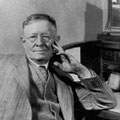Joe Richman (host): From Radio Diaries, I’m Joe Richman, and this is the final episode of The Unmarked Graveyard, a series about people buried in America’s largest public cemetery, the lives they lived, and the people they left behind.
[montage of clips from the series]
Joe Richman: Back in 1995, LaMont Dottin was 21 years old and a freshman at Queens College, when one evening, he didn’t come home. Within 48 hours, his mother was at a local police precinct trying to report him missing. His name was added to a pile of almost 20, 000 cases that the NYPD’s Missing Persons Squad was supposed to be investigating.
And LaMont’s case fell through the cracks. This is a story about the New York City Police Department and a woman’s search to find out what happened to her son.
Dr. Arnita Fowler: It took me 30 days to get him officially reported missing. My name is Dr. Anita Fowler and LaMont Dottin was my son who went missing in 1995.
I remember walking in to the precinct, there was a full room of people scurrying around, when I’m talking to a man who’s being very nonchalant with me. Now here I’m a mother, trying to report my one and only child missing. And no matter what I said, he says, “no, take my word for it, he’ll be home soon.” You know. He was considered an adult.
There was a Hispanic lady listening, and she came over, she said, “I’ll take your, uh, report, I’m not sure how far I can get it.” And then I called at least twice a week at night because that’s when they would work the shift for missing persons. One day turned into two days, and two days turned into three days, and unbelievably, months.
Kameron Brown: Definitely remember his mom being very persistent. My name’s Kameron Brown. I was a detective in the missing persons department from 1997 to 2002. She would constantly call the missing persons. She wanted to know what was going on today, what was happening.
Fowler: But they refused to meet with me and just said there’s no update or we have a new detective on it.
The case kept opening and closing, and one time I showed up and his picture wasn’t even on the board. So I said, “how are you searching for my son if his picture’s not here?”
Phillip Mahony: The missing persons squad at that time was In a state of disrepair, there was no work being done on cases, record keeping wasn’t good.
I’m Phillip Mahony. I was the commanding officer of the missing persons squad in the New York City Police Department from 1998 to 2000.
Brown: The amount of case law that each individual detective had, there was… Amazing. This was 10, 11 detectives with between 20 and 40 cases apiece. And there was not a lot of investigation.
They didn’t have vehicles for us to actually go out and do the interviews. It was just mostly phone calls at that point. You know, “hi, this is Detective Brown. You made a report on so and so missing. Did they come home? No, they didn’t. Okay, thank you.”
Mahony: I remember looking at this spreadsheet of open missing person cases. It just went on for like a hundred pages. Someone with an adult missing son that would be low on the totem pole.
Fowler: And this article is from the Daily News, November 21st, 1995. Hollis resident Arnita Fowler hadn’t had time to prepare for Thanksgiving. She’s been too busy checking city hospitals, the morgue, and jails in a desperate search for her 21 year old son. I was known as a one woman search party. I’m creating my own press conferences.
I learned how to write press releases on the fly. I would look in every homeless person’s face as I walked the streets. I go, was I crazy? But I know that I could not live the rest of my life not knowing. If he was out there,
I was 17 when I had my son, and everything I did evolved around him. He was a very loving, very loving son. He had that spirit of happiness with him, you know what I mean, like, carefree. We were always together. And I know he was saying, my mom’s gonna find me.
Mahony: I became Lieutenant and Commanding Officer of the Missing Persons Squad in 1998. Then I immediately tried to organize the Missing Persons Squad, and so we appointed a couple of people to go through that list, the hundreds and hundreds and hundreds of active cases that had accumulated over the years, page by page, name by name, and find out what happened to these people that the Missing Persons Squad never followed up on.
Brown: It felt good. I was actually out doing investigations, and we had two or three cases from, you know, the 50s. And when you really go back and still speak to parents, that same pain of their child being missing was still there.
Mahony: They would start with very basic checks, fingerprint checks, and so on. We did find a lot of people through routine checks.
Fowler: I spent four years looking for my son and then this one particular night, I was so frustrated that I picked up the phone in frustration and called and the same man who had been telling me no, it was the same guy. He said, sure, we’ll meet you. And when they came, my house was full, and it was a lady officer.
She said they had discovered that they had dotted every I and crossed every T.
Mahony: Okay, so I’m reading from a missing person’s report. The report says that the missing person was found floating in the river, October 1995, and after
Fowler: that… So apparently, eight days after Lamont went missing, they found his body.
The body would have been sent to the morgue. And their process required them to submit fingerprints.
Mahony: To identify him through fingerprints, which could be difficult if they were in the water for a long time.
Fowler: And the FBI matched it with an arrest that was made. He was arrested for a stolen car when he was in high school.
But the NYPD never followed up for results of that identification until 1999, four years later.
Mahony: “On this date, the deceased was identified as LaMont Dottin through fingerprints. In view of the facts stated above, the undersigned recommends that this case be marked closed.”
Fowler: I couldn’t imagine that this was the outcome after four years. I don’t know how he died, I do not believe it was suicide, and there was no blunt force trauma. Nothing indicating foul play.
This is the paper that shows where my son was buried at in Harts Island. There’s no name, it just says “male.” To bury my son in a place as though he had no one. As though he had no one. And I’m in your face. He was somebody’s child, and it shows the date of death and the day he was exhumed, four years later.
Brown: I remember opening the paper and seeing the picture of the body in the horse drawn carriage going around Queens. I was like, wow, if we had that case, look. And we’re all looking at it. I just can’t imagine any of my children not coming home or not knowing what happened to them. This is the Daily News September 21st, 1999.
Fowler: Student laid to rest. Four years after being buried in her papa’s grave, a missing Queens student was finally given a proper burial yesterday. And it was a perfect funeral. He was drawn by two horses and a A carriage, and the casket itself is all white, like the horses. It is what I believe that he deserved, nothing but the best.
I needed memories to be something that you could reflect on who he was. The prince that he was to me.
So Lamar is now buried at the Calverton National Cemetery. I just went there yesterday and put flowers, I just took pictures there. There are seasons of my feelings that shift. One major shift was when I realized he’s been gone longer than he’s been with me. But I can, as a mother, you know, still smell what he smell like, still hear what he laugh like.
And when I’m looking at his picture, I can imagine what he’s actually sounding like. So it’s just really, people just don’t disappear.
Joe Richman: Following years of advocacy by Fowler, New York State passed a law in 2016 requiring the police to expedite searches for missing adults. It’s called LaMont Dottin’s Law. In recent years, advances in fingerprinting and DNA technology have improved the identification of unnamed bodies in New York City.
This is the last episode in our series, The Unmarked Graveyard, Stories from Hart Island. The whole time we’ve been working on this series, Hart Island has been mostly off limits, as it has been for 150 years. But today, we are able to report that Hart Island is officially opening to the general public. Tours begin this week.
When we first started thinking about this project, I kind of imagined it as a series of audio obituaries for people who never got one. But each story became more than that. More complicated. More mysterious. More surprising. In the end, this series isn’t just about individuals buried on Hart Island.
It’s about the people who went looking for them. And the people who remember them, because once the body is gone, all that’s left are the stories.
Our story about LaMont Dottin was produced by Alissa Escarce. The producers behind our series, The Unmarked Graveyard, are Nellie Gilles, Mycah Hazel, Alissa Escarce, and myself. All the stories were edited by Ben Shapiro and Deborah George. Our NPR editor was Matt Ozug. Sound Mixing by Ben Shapiro and Mitra Kaboli. Marketing and Development by Lena Engelstein.
Theme music is by Matthias Bossi and SteelWagon Symphonette. Thanks to Melinda Hunt and the Hart Island Project. And thanks to our broadcast partner, NPRs All Things Considered, we’re proud members of Radiotopia from PRX, a network of independent creator, own listener supported podcasts. You can hear them all at Radiotopia.fm.
Radio Diaries has support from the National Endowment for the Humanities, The Lily Auchincloss Foundation, New York City’s Department of Cultural Affairs, and for listeners like you.
I’m Joe Richman of Radio Diaries, thanks for listening.








